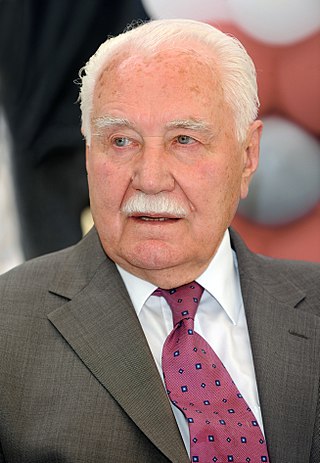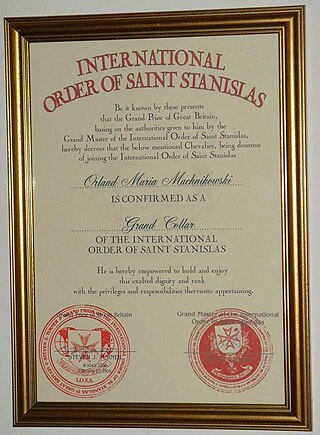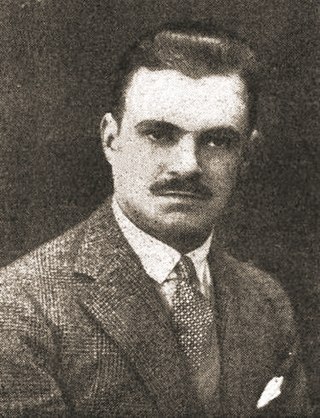Related Research Articles

The president of Poland, officially the president of the Republic of Poland, is the head of state of Poland. Their rights and obligations are determined in the Constitution of Poland. The president heads the executive branch. In addition, the president has a right to dissolve parliament in certain cases, can veto legislation and represents Poland in the international arena.

Stanisław I Leszczyński, also Anglicized and Latinized as Stanislaus I, was twice King of Poland and Grand Duke of Lithuania, and at various times Prince of Deux-Ponts, Duke of Bar and Duke of Lorraine.

The Polish government-in-exile, officially known as the Government of the Republic of Poland in exile, was the government in exile of Poland formed in the aftermath of the Invasion of Poland of September 1939, and the subsequent occupation of Poland by Germany and the Soviet Union, which brought to an end the Second Polish Republic.

The Order of the White Eagle is Poland's highest order awarded to both civilians and the military for their merits. It was officially instituted on 1 November 1705 by Augustus II the Strong, King of Poland and Elector of Saxony, and bestowed on eight of his closest diplomatic and political supporters. It is one of the oldest distinctions in the world still in use.

The Order of Polonia Restituta is a Polish state order established 4 February 1921. It is conferred on both military and civilians as well as on foreigners for outstanding achievements in the fields of education, science, sport, culture, art, economics, national defense, social work, civil service, or for furthering good relations between countries. It is Poland's second highest civilian state award in the order of precedence, behind the Order of the White Eagle.

The Order of Saint Stanislaus, also spelled Stanislas, was a Polish order of knighthood founded in 1765 by King Stanisław August Poniatowski of the Polish–Lithuanian Commonwealth. It remained under the Kingdom of Poland between 1765 and 1831. In 1831 it was incorporated under the Russian Empire until the Russian revolution (1917).
Juliusz Nowina-Sokolnicki was a Polish president and head of one of the two governments which claimed in 1972 to be the successor to the exiled Polish government that was created to replace original Polish government, which fled to Romania in September 1939 at the start of World War II. The legitimacy of his government was disputed.

Ryszard Kaczorowski, GCMG was a Polish statesman. From 1989 to 1990, he served as the last President of Poland-in-exile. He succeeded Kazimierz Sabbat, and resigned his post following Poland's regaining independence from the Soviet sphere of influence and the election of Lech Wałęsa as the first democratically elected President of Poland since before the Second World War. He died on 10 April 2010 in the plane crash near Smolensk, Russia, along with the President of Poland Lech Kaczyński and other senior government officials.

The International Order of Saint Stanislaus is a Polish fraternal order founded on 16 May 2004.

The Imperial Order of Saint Stanislaus, also spelled Stanislas or Stanislav, is a Russian dynastic order of knighthood founded as Order of the Knights of Saint Stanislaus, Bishop and Martyr in 1765 by King Stanisław II Augustus of the Polish–Lithuanian Commonwealth. In 1831 after the downfall of the November Uprising, the order was incorporated into the Chapter of Russian Orders as part of the honours system of the Russian Empire by Emperor Nicholas I of Russia.

August Zaleski was a Polish economist, freemason, politician, and diplomat. Twice Minister of Foreign Affairs of the Republic of Poland, he served as President of Poland-in-exile.
Rotmistrz Ryszard Dembiński was a Polish Cavalry officer and D-Day Veteran, who, following World War II, helped to establish the Polish Institute and Sikorski Museum in London, which he chaired for 25 years (1979–2004).
The Order of Saint Stanislaus may refer to:

Konstanty Rokicki was a Polish consular officer, vice consul of the Republic of Poland in Riga and Bern, and a Holocaust rescuer. Between 1941 and 1943 he was a member of the Ładoś Group also called the Bernese Group. Rokicki used his diplomatic position of vice consul to produce false Latin American passports and had them smuggled to the German-occupied Poland and Netherlands where they saved lives of their Jewish bearers. For his efforts Rokicki was named Righteous Among the Nations by Israel in 2019.

Juliusz Kühl also known as Julius or Yehiel Kühl was a Polish diplomat, Holocaust rescuer and – after the World War II – Canadian construction businessman. Kühl was a member of the Ładoś Group also known as the Bernese Group and he is particularly known for his role in the production of false Latin American passports by the Polish Legation in Bern, Switzerland, thanks to which between several hundred and several thousand Jews in German-occupied Poland and Netherlands survived the Holocaust.
Szymon Zabiełło was a Polish-Lithuanian nobleman of the Topór clan. He was the castellan of Minsk from 1783 to 1787, lieutenant general of the Grand Ducal Lithuanian Army, and a member of its General Staff in 1792. He was an envoy to the Grodno Sejm, a member of the Patriotic Party, the Grodno Confederation in 1793, as well as the Permanent Council, and a participant of the Kościuszko Uprising in Lithuania.
References
- 1 2 "Recreation of the Order". The Order of Saint Stanislas. Sankt Stanislaus Orden Österreich - Karitativer Ritterorden. Retrieved 14 December 2012.
In his function as President of the Republik of Poland (in Exile), although not recognised by all Polish emigree groups Juliusz Novina Sokolnicki held the office and supported the Polish opposition against the totalitarian communist regime in Poland and other countries under Soviet influence. On 9 June 1979 he recreated the Sovereign Order of Saint Stanislas and declared himselfVIII Grand Master of the Order of St Stanislas The term "sovereign" was dropped later after the separation of the Order from the Polish State.1990 he transferred all rights and duties of the Office of the President of the Republic of Poland in Exile to the now free and sovereign State of Poland and retired from politics. The main field of his activity became the Order of Saint Stanislaus, which he made an autonomous association of charity. The last event in which he participated was on 9 May 2009, the 131st Investiture of the Order, connected with the event of 30 years of activities of the organization at Jasna Góra in Czestochowa.
- ↑ Duckers, Peter (2008). European orders and decorations to 1945. Botley, Oxford, UK: Shire Publications. pp. 67–79. ISBN 9780747806707.
- ↑ Duren, Peter Bander van (1995). Orders of knighthood and of merit: the pontifical, religious and secularised Catholic-founded Orders and their relationship to the Apostolic See. Gerrards Cross: Smythe. pp. 380–86, 682–90. ISBN 9780861403714.
- 1 2 "About the Order of Saint Stanislas". British Association of Chevalier's of Saint Stanislas, The International Order of Saint Stanislas. London: British Association of Chevalier's of Saint Stanislas. Archived from the original on 23 April 2011. Retrieved 12 December 2012.
The 1st elected President of the democratic Poland, Lech Walesa, was presented with the Presidential insignia and seals of the Grand Master of the Orders of the White Eagle and Polonia Restituta on 22 December 1990, by Ryszard Kaczorowski and not Nowina-Sokolnicki. There were further problems in the Order when Nowina-Sokolnicki declared the Grand Mastership of the Order to be the hereditary prerogative of his family, and on the 1st January, 1997, the National Chapter announce the dismissal of Nowina-Sokolnicki and the election of Count Kazimierz Dworak-Biziel-Dworakowski, a resident of the USA, as the 8th Grand Master. At the same time the Catholic Church of Poland recognised Marek Kwiatkowski as Grand Master of the Order and he headed an alternative Chapter...On the 16th May, 2004, a number of Grand Priors from various Countries met in Kiev, Ukraine, and decided to split from Nowina-Sokolnicki’s Order and form the International Order of St Stanislas. We do not claim to be the authenticate original Order, only that we follow their basic principles and precepts. We recognise that there are several Orders of St. Stanislas and are happy to welcome members of any of them to our functions and acknowledge that each in their own way do good works
- 1 2 Kurek, Eaglan (2010). "History". West European Grand Priory, International Order of Saint Stanislas. Retrieved 12 December 2012.
On the 16th May, 2004, a number of Grand Priors from various Countries met in Kiev, Ukraine, and decided to split from Nowina-Sokolnicki’s Order and form the International Order of St Stanislas. We do not claim to be the authenticate original Order, only that we follow their basic principles and precepts. We recognise that there are several Orders of St. Stanislas and are happy to welcome members of any of them to our functions and acknowledge that each in their own way do good works. Although originally a Christian Order membership is now open to any male or female over the age of 21, (18 by agreement of the Grand Prior), who profess a belief in a Supreme Being and is a believer in the fundamental principles of chivalry.
- ↑ "About Order". International Order of Saint Stanislas. Retrieved 14 December 2012.
The International Order of Saint Stanislas is a charitable and guerdon organization, recognized all over the world. It is an alliance of national associations of the Order members.
- ↑ "Constitution". Order of Saint Stainslas. Sankt Stanislaus Orden Österreich - Karitativer Ritterorden. Retrieved 14 December 2012.
- 1 2 "Zmarł samozwańczy prezydent Polski". Newsweek (Poland) (in Polish). 26 August 2009. Retrieved 14 December 2012.
W 1990 roku ogłosił się Wielkim Mistrzem Orderu Świętego Stanisława (orderu rycerskiego istniejącego w XVIII i XIX wieku) i zajął się nadawaniem go w Polsce i zagranicą. W związku z tym w 2006 roku senator PiS Dorota Arciszewska-Mielewczyk powiadomiła prokuraturę o możliwości popełnienia przestępstwa podszywania się pod funkcjonariusza publicznego. Śledztwo jednak umorzono....Przed śmiercią Nowina-Sokolnicki wskazał na swojego następcę Jana Zbigniewa Potockiego, polskiego biznesmena zamieszkałego w Niemczech. Potocki zdążył już się ogłosić nowym prezydentem wolnej Polski na wychodźstwie.
- 1 2 Graff, Alexander. "Jan Zbigniew Potocki". Ordo Sancti Stanislai. Vienna: Sankt Stanislaus Orden Österreich - Karitativer Ritterorden. Retrieved 12 December 2012.
Jan Zbigniew Potocki followed Juliusz Nowina Sokolnicki as IXth Grand Master of the Order in August 2009. He was dismissed from his position as Grand Master in February 2010, after he violated the Constitution of the Order repeatedly...The Order was then governed by the Regency Council internationally. The Confederacy of Priories and Commandories governed the Order in Poland
- ↑ "Inauguration of the Xth Grand Master". Order of Saint Stanislas. Sankt Stanislaus Orden Österreich - Karitativer Ritterorden. Retrieved 14 December 2012.
- ↑ "Standpoint of the Priors and Commanders of the Polish Grand Priory of The Order of Saint Stanislaus BM passed during the VI Conference in Warsaw on the 16th of February 2011". Royal Order of St. Stanislaus BM. Polish Grand Priory of the Order of Saint Stanislas. Retrieved 14 December 2012.
- 1 2 "Sokolnicki Juliusz". Juliusz Nowina Sokolnicki, Biblioteka Uniwersytecka UMK w Toruniu, Archiwum Emigracji, “Dokumenty Urzędu Prezydenta RP” (in Polish). Retrieved 12 December 2012.
1967-70 Minister Informacji i Dokumentacji, 1970 minister spraw wewnętrznych i minister spraw krajowych, 1971 wyznaczony na następcę prezydenta Rzeczypospolitej, 1972-90 prezydent Rzeczypospolitej.
- ↑ "Kancelaria Prezydenta RP". www.president.pl. Archived from the original on 23 February 2005.
- ↑ "Senat Rzeczypospolitej Polskiej / Nie znaleziono szukanej strony". Archived from the original on 18 February 2012. Retrieved 22 May 2016.
- ↑ Juliusz Nowina-Sokolnicki (1920-2009), Autor: Norbert Wójtowicz (pl)
- ↑ "Ryszard Kaczorowski". The Official Website of the President of the Republic of Poland. BBN Biuro Bezpieczeństwa Narodowego. Retrieved 30 December 2011.
Ryszard Kaczorowski...handed over the insignia of the presidential power of the 2nd Republic to President Lech Walesa
- ↑ "August Zaleski". The Official Website of the President of Poland. Warsaw: Biuro Bezpieczeństwa Narodowego. Retrieved 12 December 2012.
Having assumed the office of the President in exile (April 1947), he appointed General Tadeusz Bor-Komorowski Prime Minister. Having completed a 7 years term of office, he extended the term indefinitely. One of his adherents was Cat-Mackiewicz who replaced him at the post of Prime Minister, where as General Anders refused to obey him. Before his death in April 1972 he designated Stanislaw Ostrowski as his successor.
- ↑ Ferfecki, Wiktor (8 August 2009). "Zmarł samozwańczy prezydent Polski". TVP.info (in Polish). Retrieved 14 December 2012.
Działał równolegle z rzeczywistymi prezydentami na uchodźstwie aż do 1990 r., gdy oficjalnie przekazał insygnia władzy prezydenckiej Lechowi Wałęsie
- ↑ Anna, Luigi G. De, ed. (2003). Milites pacis : Military and peace services in the history of Chivalric orders : proceedings of the Conference: The Monks of War - the Monks of Peace, Military and Peace Services in the History of Chivalric Orders, Turku 15. - 26. 5- 2001. Turku: University of Turku Press. p. 88. ISBN 9789512924257.
- ↑ Ward, Gary L., Bertil Persson, & Alan Bain, eds (1990). Independent bishops : an international directory. Detroit, Mich.: Apogee Books. p. 380. ISBN 9781558883079.
{{cite book}}:|first=has generic name (help) - ↑ "Fałszywy blask fałszywych orderów fałszywego "prezydenta" RP Nowiny-Sokolnickiego". Nowy Ekran (in Polish). 11 August 2011. Retrieved 14 December 2012.
Sąd Wojewódzki w Warszawie 27 stycznia 1997 zarejestrował Stowarzyszenie Kawalerów Orderu św. Stanisława z siedzibą w Łazienkach Królewskich, konkurencyjne wobec poczynań Sokolnickiego. Na "nowego” Wielkiego Mistrza tej kapituły OSS został wybrany książę Zbigniew Kazimierz. Objęcie funkcji miało bardzo ceremonialny charakter i odbyło w miejscu śmierci świętego Stanisława BM w Krakowie na Skałce. Wielki Mistrz złożył przysięgę na relikwie świętego, Wielki Kanclerz Kapituły OSS otrzymał przy okazji Wielki Łańcuch Suwerennego, Rycerskiego i Religijnego Orderu Korony Cierniowej, a potem dokonano inwestytury nowych kawalerów i dam. Oprócz rodzonego brata Wielkiego Mistrza znalazło się tam kilka naprawdę znanych osób, w tym m. in. dyrektorzy Łazienek czy Muzeum Wojska Polskiego w Warszawie. Potem odbył się bankiet na Wawelu, książę Zbigniew Kazimierz udzielił wywiadów dla Źródła i Gościa Niedzielnego , którym w swym angielskojęzycznym biuletynie (OSS Newsletter nr 1/1997) przypisał, bagatela, po milionie egzemplarzy nakładu tygodniowo.
- ↑ "Who Are We?". Order of Saint Stanislas. Sankt Stanislaus Orden Österreich - Karitativer Ritterorden. Retrieved 14 December 2012.
The Order of Saint Stanislas is a hierarchically organized body of men and women, many with a Polish Connection, who support and assist in charitable works of various kinds to help the poor and disadvantaged in Poland and in other countries throughout the world. Originally a dynastic chivalric order from Poland, it is now an international charitable non-profit association in the form of a private chivalric order. As an international non-profit association, we transcend discrimination by race, religion, sex, and other prejudicial ideas. Our aims during the Cold War were focused on helping the people of Poland and it's diaspora with money from the Free World to make life more tolerable. After the fall of the Iron Curtain, our charitable works have expanded to helping the poor in all parts of the globe. We uphold the traditions of chivalry, with each member working at themselves to be an honest and charitable person. We do not fight with the sword for all that is good or right; our weapons are our words and deeds - the examples of our actions! We espouse the idea of a worldwide brotherhood of all people on this earth, with no discrimination based on skin color, religious beliefs, political or social orientation. We strive to help others, whether it be with labor or money, wherever the need is. Anyone who feels motivated by the principles of the Order is welcomed to contact us to apply for admission